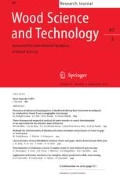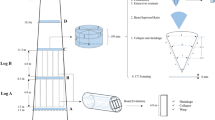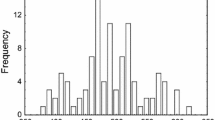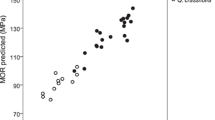Summary
An examination of shrinkage behaviour in a range of tree species has demonstrated clear differences between eucalypts and other species with respect to the volumetric shrinkage (S)/specific gravity (ϱ) ratio. The equation S=fϱ proposed by Stamm (1935a, 1952) to relate this ratio to the fibre saturation point (f) was inapplicable in eucalypts, both before reconditioning, where a highly negatively significant linear correlation was observed between S and ϱ, and after reconditioning where the correlation was not significant and the regression line indicated S to be nearly constant. Collapse was found to be highly negatively correlated with specific gravity in the eucalypt species and evidently was primarily responsible for the negative S/ϱ relationship before reconditioning.
In non-eucalypts S and ϱ were highly positively correlated, but the regression line did not pass through the origin and the slope was 10 to 14% less than the value of 28% suggested by Stamm for f. Only when the regression line was artificially forced through zero did the slope approach postulated fibre saturation point values. A power function was proposed as representing a more reasonable fit of the data.
In line with these analyses, unit shrinkage (Su) was shown not to be equivalent to ϱ. This lack of equivalence was expressed as Su divided by basic density (γ) which was termed the R-ratio and which was shown to be equal to the change in volume during shrinkage (or swelling) divided by the associated change in the weight of an equivalent volume of water. R was seldom equal to one, as required by the Stamm formula, and was negatively correlated with specific gravity in both eucalypts and non-eucalypts. A comparison of regression equations showed R values for eucalypts to be significantly different from those of non-eucalypts. Possible uses for the R-ratio were considered.
Similar content being viewed by others
References
Anonymous 1982: Properties of the important Japanese woods. Table of the properties of woods. Bull. Forestry For. Prod. Res. Inst. No. 319, 85–126
Beiser, W. 1933: Mikrophotographische Quellungsuntersuchungen Fichten- und Buchenholz an Mikrotomschnitten im durchfallenden Licht und an Holzklötzchen im auffallenden Licht. Kolloid Z. 65: 203–211
Chafe, S. C. 1985: The distribution and interrelationship of collapse, volumetric shrinkage, moisture content and density in trees of Eucalyptus regnans F. Muell. Wood Sci. Technol. 19: 329–345
Chafe, S. C. 1987: Collapse, volumetric shrinkage, specific gravity and extractives in Eucalyptus and other species. Part 2: The influence of extractives. Wood Sci. Technol. 21: (in print)
Greenhill, W. L. 1936: The shrinkage of Australian timbers. Part 1. A new method of determining shrinkages and shrinkage figures for a number of Australian species. CSIRO Div. For. Prod. Technol. Pap. No. 21, 1–54
Greenhill, W. L. 1937: The density of Australian timbers. Air dry and green density for a number of species. CSIR J. 10: 241–250
Kelsey, K. E. 1956: The shrinkage intersection point. Its significance and the method of its determination. Forest Prod. J. 6: 411–417
Keylwerth, R. 1962: Untersuchungen über freie und behinderte Quellung von Holz — 1. Mitteilung: Freie Quellung. Holz Roh-Werkstoff 20: 252–259 (CSIRO Transl. No. 6241A)
Kingston, R. S. T.; Risdon, C.; June, E. 1961: Shrinkage and density of Australian and other south west Pacific woods. CSIRO Div. For. Prod. Technol. Pap. No. 13, 1–65
Newlin, J. A.; Wilson, T. R. C. 1919: The relation of the shrinkage and strength properties of wood to its specific gravity. USDA For. Prod. Lab. Bul. No. 676, 1–35
Schwalbe, C. G.; Beiser, W. 1933: Die Quellung von Holz durch Wasser und wäßrige Lösungen. Papier-Fabrikant No. 50, 655–667
Sekhar, A. C.; Rajput, S. S. 1967: Some studies on the shrinkage behaviour of wood. Wood Sci. Technol. 1: 100–108
Stamm, A. J. 1935a: Shrinking and swelling of wood. Ind. Eng. Chem. 27, 401–406
Stamm, A. J. 1935b: The effect of changes in the equilibrium relative vapor pressure upon the capillary structure of wood. Physics 6, 334–342
Stamm, A. J. 1952: Surface properties of cellulosic materials. In: Wise, Louis E.; Jahn, Edwin J. (Eds.): Wood chemistry (2nd ed.). New York: Reinhold, p. 691–814
Stamm, A. J. 1964: Wood and cellulose science. New York: Ronald Press
Vorreiter, L. 1963: Fasersättigungsfeuchte und höchste Wasseraufnahme der Hölzer. Holzforschung 17: 139–146
Author information
Authors and Affiliations
Rights and permissions
About this article
Cite this article
Chafe, S.C. Collapse, volumetric shrinkage, specific gravity and extractives in Eucalyptus and other species. Wood Sci.Technol. 20, 293–307 (1986). https://doi.org/10.1007/BF00351583
Received:
Issue Date:
DOI: https://doi.org/10.1007/BF00351583




